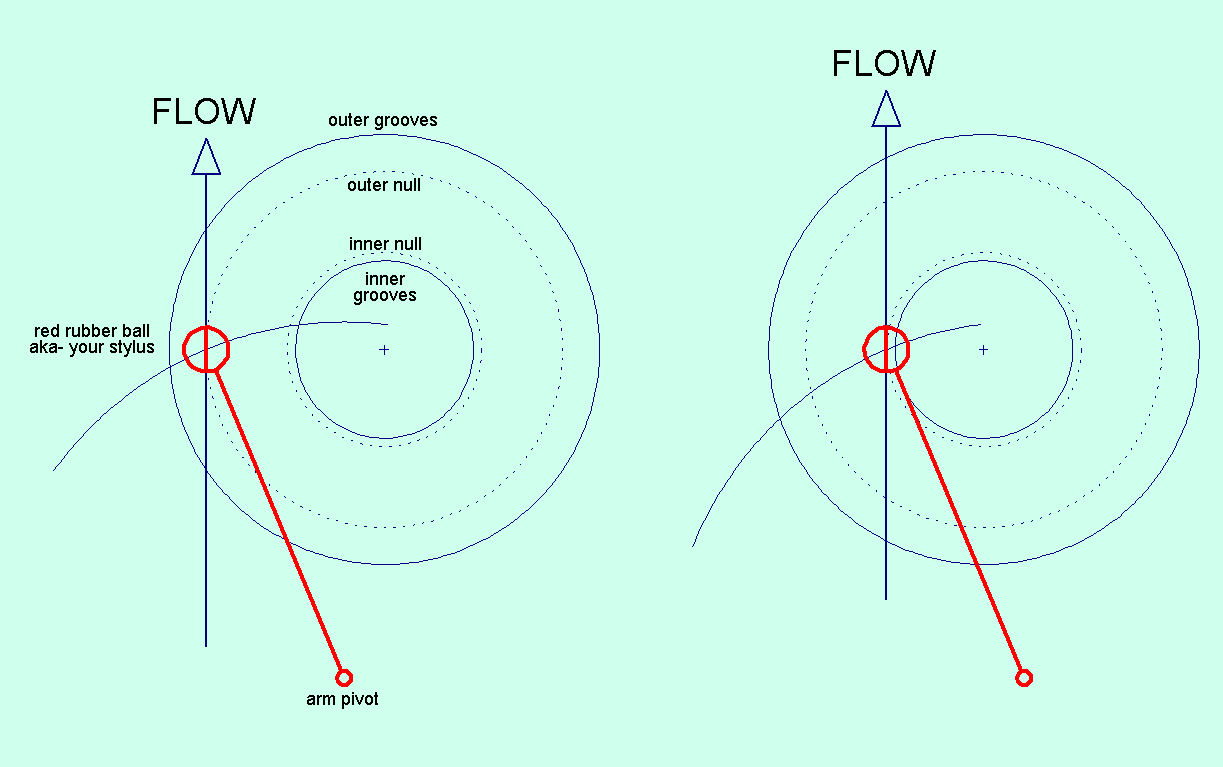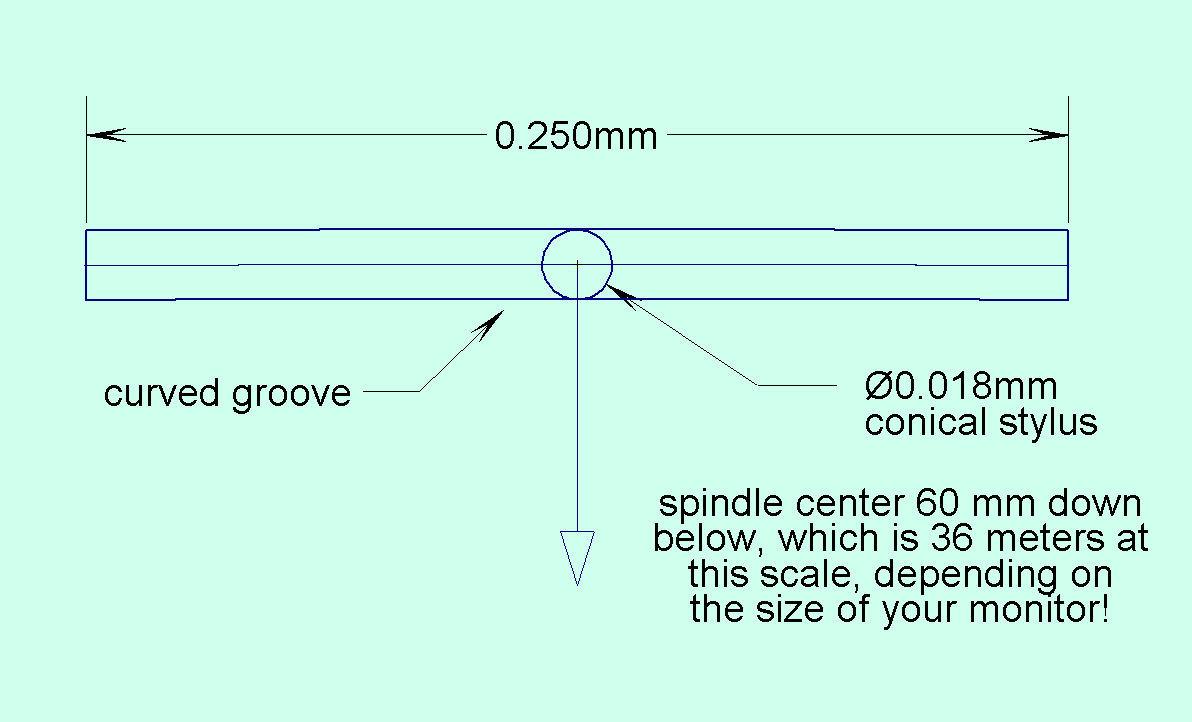
A simple explanation of tone arm anti-skate forces can be hard to find. The technically savvy usually resort to free-body diagrams, which frighten the children, put most of us to sleep and often do little to improve understanding if you're not used to working with them. Anti-skate forces have a simple underlying cause, but there are various secondary effects that need to be considered once the basic cause is understood.
You go down to the river that curves around the town. It's wide, shallow and flows smoothly. In your pocket is a red rubber ball that you attach to the end of a long stick. You wade out into the river and stand looking downstream. Holding the end of the stick, you put the ball in the water. It floats and tries to go downstream. Holding the end of the stick so the experiment doesn't float away, you notice several things. First, no matter where you stand, the stick always remains parallel to the flow of the water. If you force the ball left or right, the flow always brings it back to center. You also notice that, even though the river curves around the town, the flow of the water in your immediate area appears straight; on the scale of the ball (and you) the curvature of the river has no effect.
The ball-in-water analogy is very similar to what happens with a linear tracking tone arm. As the record groove "flows" past the stylus, all the forces are in-line with the arm pivot, arm tube and cantilever. As the record plays, the arm pivot point has to move to maintain that happy state of affairs, but it avoids all manner of problems we're about to discuss. The trade-off with a linear tracking arm is the more complex mechanism needed to move the pivot. Complexity is money and thus the vast majority of turntables eshew linear tracking and use the traditional pivoted arm we all know and love.
Early on it was realized that a simple pivoting straight arm caused the cartridge to be severely misaligned at all but one point across the record. The cure for this disease was to angle the cartridge. Following the formula of Lofgren and others, perfect alignment could be achieved at two points (the null points) and the error across the rest of the record could be reduced to insignificance, or at least close. A tone arm with a 225 mm pivot to spindle distance, using Lofgren A (Baerwald) alignment, will have a worst case error of two degrees at the beginning of the record. The effective length of said arm, the pivot to stylus distance, will be 242 mm.
We can ignore the fact that we're dealing with a round spinning record. The ball-in-water analogy remains useful as we can consider the flowing water as the record surface "flowing" past the stylus at any given point on the record. The "flow" will always be tangent to a circle drawn at the radius of the stylus. For convenience, we'll use the two null points in the diagrams below, but the rule applies across the entire playing surface.
Like most drugs, the cure for misalignment comes with some side effects. The above mentioned tone arm will have the cartridge twisted at 22.7 degrees. Searching your pockets you find a waterproof marker, so you draw a line on the ball at 22.7 degrees from the axis of the stick, the same angle as the cartridge at the end of our tone arm. Just as our cantilever has to be tangent to the groove radius, in our analogy this line has to be parallel to the water flow. You put the ball back in the water and, just as before, and the ball goes directly downstream, with the line not at all parallel to the flow.
You reach out with your finger and push the ball to the left until the line is parallel to the water flow. The stick is now at 22.7 degrees and you're pushing the ball to the left with exactly the same force that the flowing water is generating towards your finger. Congratulations, you've just applied anti-skate force to balance the skating force!
It should be an easy leap to translate the ball-in-water experiment to the diagrams below. They show the stylus at the outer and inner null radius, with the diagrams rotated so the "flow" is always vertical. The "flow" applies a force that, unrestrained by grooves or your finger, would push the stylus to be in line with the arm pivot, not in the unnatural location over to the left, where it correctly aligns tangent to the groove radius.

Note that for the arm geometry described, the pivot point is always 93.45 mm to the right of the stylus. That's also known as the offset distance of the arm and is helpful in understanding why the skating force is always present. No matter where the stylus is on the record, the arm pivot is about 93.45 mm inboard, resulting in about the same skating force.
In the case of the tone arm, the record groove controls where the stylus is, rather than your finger, but the force is still there, increasing the pressure against the inboard side of the stylus. Turntables without anti-skate will wear the stylus more on the inboard side, not to mention that the force difference causes the onset of mistracking to happen sooner on the unloaded outboard side.
The record is round and this is the source of much confusion. The path of the groove is curved and that would seem to complicate the matter of exactly what direction the arm is being pulled. Or, perhaps the groove wall being convex on the inboard side of the stylus, and concave on the outboard side of the stylus has some uneven effect. Like the river curving around the town, on the scale of the stylus the groove is almost perfectly straight. In the diagram below, a conical stylus is drawn to scale with the inner groove. It's been drawn with the platter pivot straight down for a better display on your monitor. Can you see the curvature? Barely, and those lines really are arcs drawn in the CAD program. Depending on the size of your monitor, the platter spindle is about 36 meters below where you're sitting. At the scale of the stylus, the groove can be considered straight. The curvature issue is a red herring.

Let's take a moment to think about the dynamic friction of the stylus in the record groove vs. the viscous drag of the ball in water. They are two very different things. Dynamic friction is defined by a frictional coefficient. The speed of motion isn't considered. If you have a coefficient of 0.5, it means that for a down-force of say, 2 grams, it will take 1 gram to drag whatever-it-is across a surface. How fast you drag it across has little effect. Double the downforce however, and you double the drag force.
Viscous drag is complex and is speed dependent. The faster you go, the more drag you get. Now, viscous drag doesn't really describe a stylus in a groove, but it's similar. The modulation of the groove puts an additional drag on the system, and the higher the frequency or the faster you go, the worse it gets. Thus, the ball-in-water analogy isn't entirely inappropriate. You can find other papers that put some numbers to these things, but plain friction appears to be larger effect. When it comes to exactly what your particular hardware is doing there's really no good and accurate way to pin the numbers down. You need a test to tell you how well the anti-skate setting is working so you can optimize it.
If your cartridge is reasonably high compliance, you may have noticed that the centering of the cantilever depends on the anti-skate setting. The force that pulls the arm towards center also flexes the cantilever towards the outboard side of the cartridge body. The anti-skate force pulls the arm outboard, and when the two forces cancel, the cantilever should be centered. At least it should be if that was its normal resting position off the record. Thus, if you note exactly where the cantilever rests in mid air, and then adjust the anti-skate for the same position while playing a record, the setting should be quite close to correct.
Some people make the adjustment using a blank section of record, or a smooth plastic mat on top. This is way better than nothing, but can result in an adjustment that's below optimum. Or not, because the drag isn't the same nor is it predictable between the stylus being in a modulated 45 degree groove, or riding on a flat surface.
If you have a test record with increasing levels of mono program, mistracking will occur at about the same level when the anti- skate is correctly adjusted. This is best checked with headphones and is probably the best method.
C. Hoffman
last major edit May 27, 2017